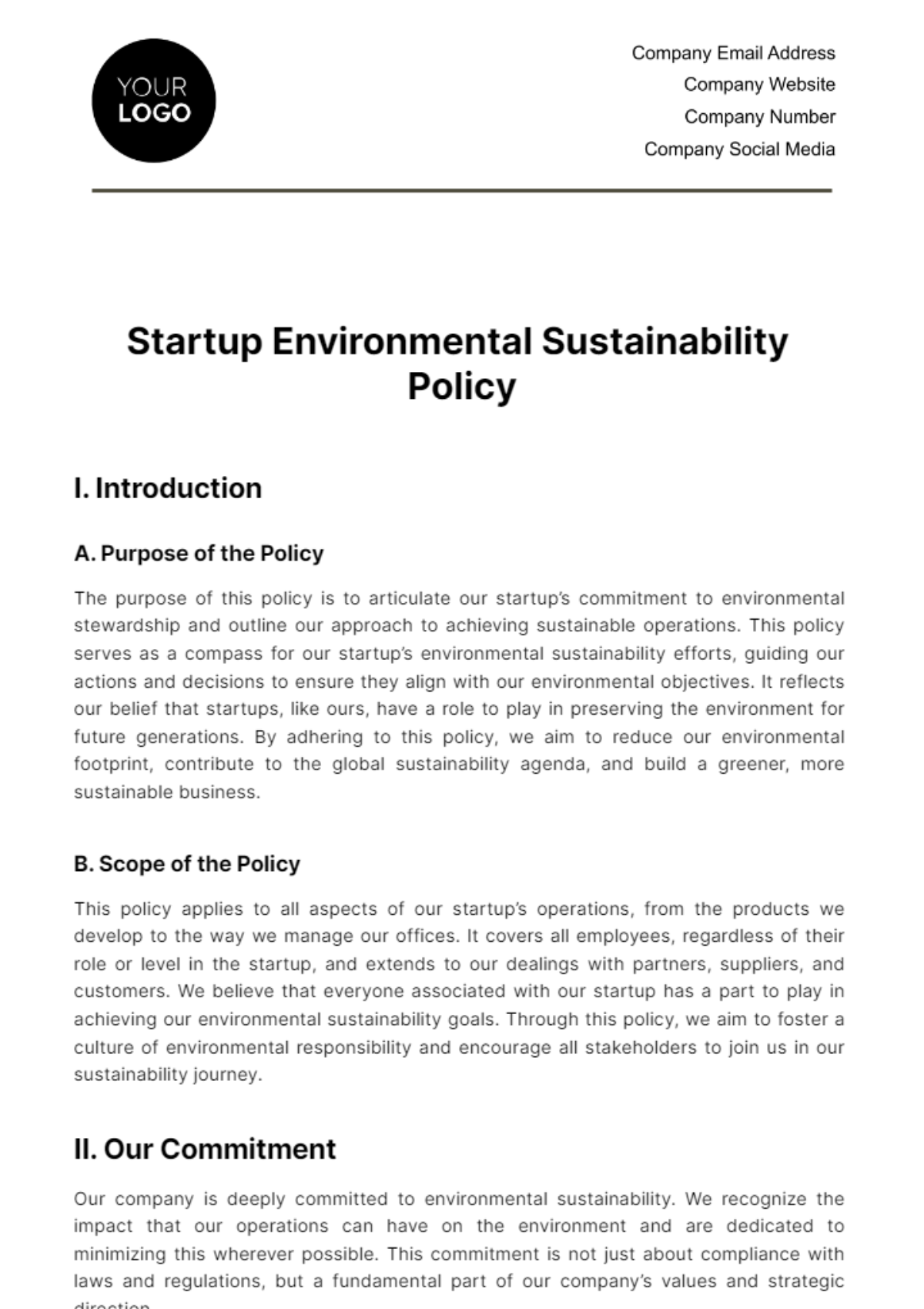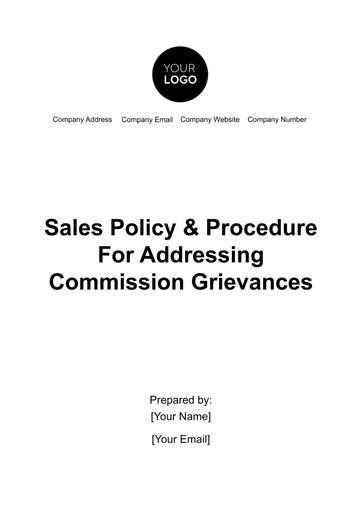Free Startup Environmental Sustainability Policy

I. Introduction
A. Purpose of the Policy
The purpose of this policy is to articulate our startup’s commitment to environmental stewardship and outline our approach to achieving sustainable operations. This policy serves as a compass for our startup’s environmental sustainability efforts, guiding our actions and decisions to ensure they align with our environmental objectives. It reflects our belief that startups, like ours, have a role to play in preserving the environment for future generations. By adhering to this policy, we aim to reduce our environmental footprint, contribute to the global sustainability agenda, and build a greener, more sustainable business.
B. Scope of the Policy
This policy applies to all aspects of our startup’s operations, from the products we develop to the way we manage our offices. It covers all employees, regardless of their role or level in the startup, and extends to our dealings with partners, suppliers, and customers. We believe that everyone associated with our startup has a part to play in achieving our environmental sustainability goals. Through this policy, we aim to foster a culture of environmental responsibility and encourage all stakeholders to join us in our sustainability journey.
II. Our Commitment
Our company is deeply committed to environmental sustainability. We recognize the impact that our operations can have on the environment and are dedicated to minimizing this wherever possible. This commitment is not just about compliance with laws and regulations, but a fundamental part of our company’s values and strategic direction.
Compliance: We are committed to complying with all relevant environmental legislation, regulations, and requirements. This is the foundation of our environmental sustainability efforts. We will stay informed about the latest environmental standards and best practices in our industry and strive to exceed them whenever possible.
Prevention: We aim to prevent environmental damage and minimize our environmental footprint. This involves managing our operations in a way that reduces waste, conserves resources, and minimizes pollution. We believe that prevention is better than cure when it comes to environmental protection.
Efficiency: We strive to improve efficiency in the use of resources throughout our operations. This includes energy, water, and materials. By using resources more efficiently, we can reduce our environmental impact, save money, and improve our operational efficiency.
Education: We are committed to educating our employees about environmental issues and encouraging them to work in an environmentally responsible manner. We believe that every employee has a role to play in achieving our environmental goals and will provide them with the knowledge and resources they need to contribute effectively.
Engagement: We will engage with our stakeholders on our environmental commitments and performance. This includes employees, customers, suppliers, and the community. We believe that open and transparent communication about our environmental efforts is key to building trust and driving progress.
III. Environmental Practices
Our environmental practices are the concrete actions we take to fulfill our commitment to environmental sustainability. They are designed to minimize our environmental impact and promote sustainable operations.
A. Resource Management
Resource management is a key aspect of our environmental practices. It involves using our resources—energy, water, and materials—in the most efficient and sustainable way possible.
Energy Efficiency: We will implement energy-efficient practices in all aspects of our operations. This includes optimizing our use of lighting, heating, cooling, and equipment in our facilities. We will also explore renewable energy options, such as solar or wind power, where feasible. Regular energy audits will be conducted to identify opportunities for energy conservation.
Water Conservation: Water is a precious resource, and we are committed to using it responsibly. We will implement water-saving measures in our facilities, such as low-flow faucets and toilets, and efficient irrigation systems for any landscaping. We will also strive to reduce water usage in our manufacturing processes, if applicable.
Waste Management: We are committed to reducing waste generation through a comprehensive waste management strategy. This includes minimizing waste production at the source, recycling and reusing materials where possible, and ensuring responsible disposal of waste. We will also explore opportunities for waste-to-energy conversion where feasible.
B. Sustainable Procurement
Sustainable procurement is about making purchasing decisions that have positive social, economic, and environmental impacts.
Evaluate Suppliers: We will assess the environmental performance of our suppliers as part of our procurement process. Suppliers with strong environmental credentials will be given preference.
Choose Sustainable Products: We will prioritize products and services that have a lower environmental impact over their life cycle. This includes considering factors such as energy efficiency, durability, use of recycled materials, and end-of-life disposal when making purchasing decisions.
Encourage Suppliers: We will work with our suppliers to encourage them to adopt sustainable practices. This could involve providing incentives for suppliers who demonstrate improvements in their environmental performance.
C. Employee Engagement
Our employees play a crucial role in our environmental sustainability efforts. We believe that fostering a culture of sustainability requires the participation and commitment of all employees.
Educate Employees: We will provide regular training and resources to help our employees understand environmental issues and how they can contribute to our sustainability efforts. This could include workshops, seminars, or online training modules.
Encourage Participation: We will create opportunities for employees to participate in our environmental initiatives. This could include volunteering for environmental clean-up activities, participating in recycling programs, or contributing ideas for improving our environmental performance.
Recognize Contributions: We will recognize and reward employees who make significant contributions to our environmental sustainability efforts. This could include awards, public recognition, or other incentives.
IV. Monitoring and Review
Monitoring and review are integral components of our policy. They ensure that our environmental practices are effective and that we are making progress towards our environmental goals.
Monitoring and Review Activities | Description |
|---|---|
Regular Audits | Conduct regular environmental audits to assess our compliance with this policy and identify areas for improvement. |
Performance Metrics | Establish and track performance metrics to measure our environmental performance over time. |
Policy Review | Review this policy at least annually to ensure it remains relevant and effective. |
Reporting | Regularly report on our environmental performance to our stakeholders. |
Regular Audits: Regular audits are conducted to assess our compliance with this policy and identify areas for improvement. These audits involve a thorough examination of our operations, processes, and practices to ensure they align with our environmental commitments. They help us identify any gaps or shortcomings in our environmental performance and develop action plans to address them.
Performance Metrics: Performance metrics provide a quantitative measure of our environmental performance. These metrics might include energy use, water consumption, waste generation, and carbon emissions. By tracking these metrics over time, we can measure our progress towards our environmental goals, identify trends, and make data-driven decisions to improve our environmental performance.
Policy Review: Regular reviews ensure that our policy remains relevant and effective. These reviews involve assessing the effectiveness of our policy in guiding our environmental practices and achieving our environmental goals. They also consider changes in environmental regulations, industry best practices, and our own operations that might necessitate updates to our policy.
Reporting: Reporting keeps our stakeholders informed about our environmental performance. We believe in transparency and accountability when it comes to our environmental commitments. Regular reporting allows us to communicate our environmental performance to our employees, customers, investors, and the wider community. It also allows us to receive feedback and engage our stakeholders in our environmental sustainability efforts.
These processes provide a mechanism for us to assess the effectiveness of our environmental practices and make necessary adjustments. They allow us to track our progress towards our environmental goals and demonstrate our commitment to environmental sustainability. By regularly monitoring and reviewing our environmental performance, we can ensure that our company continues to reduce its environmental impact and contribute to a sustainable future.
V. Communication
Communication is a vital aspect of our Environmental Sustainability Policy. It ensures that all stakeholders are aware of our environmental commitments and performance, and it provides a platform for dialogue and engagement on environmental issues.
A. Internal Communication
We believe that every employee plays a crucial role in implementing our Environmental Sustainability Policy. Therefore, we will:
Inform: Keep all employees informed about our Environmental Sustainability Policy and their roles in implementing it. This could be done through staff meetings, newsletters, or our internal communication platform.
Educate: Provide regular training and resources to help employees understand environmental issues and how they can contribute to our sustainability efforts. This could include workshops, seminars, or online training modules.
Engage: Encourage employees to share their ideas and feedback on our environmental practices and sustainability initiatives. This could be done through suggestion boxes, surveys, or brainstorming sessions.
B. External Communication
We also recognize the importance of communicating with our external stakeholders, including customers, suppliers, investors, and the wider community. Therefore, we will:
Disclose: Regularly disclose our environmental performance to our stakeholders. This could be done through sustainability reports, our website, or public statements.
Collaborate: Collaborate with our suppliers, customers, and other partners on sustainability initiatives. This could involve joint projects, sharing of best practices, or participation in industry forums.
Engage: Engage with the wider community on our environmental commitments and initiatives. This could involve community events, public consultations, or social media engagement.
- 100% Customizable, free editor
- Access 1 Million+ Templates, photo’s & graphics
- Download or share as a template
- Click and replace photos, graphics, text, backgrounds
- Resize, crop, AI write & more
- Access advanced editor
Embed sustainability into your startup easily with this customizable Startup Environmental Sustainability Policy Template, exclusively available on Template.net! This editable policy document is your go-to solution for efficiently integrating environmental practices. Leverage the AI Editor Tool for a versatile policy to ensure you are hitting your startup's specific sustainability goals!
You may also like
- HR Policy
- Restaurant Policy
- Company Policy
- Accounting Policies and Procedures
- Website Policy
- Privacy Policy
- Safety Policy
- School Policy
- IT and Software Policy
- Law Firm Policy
- Construction Policy
- Interior Design Policy
- Travel Agency Policy
- Education Academic Policy
- Security Policy
- Real Estate Policy
- Expense Policy
- Software Policy





























